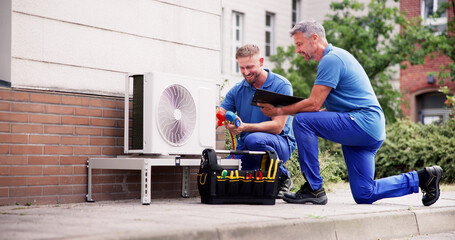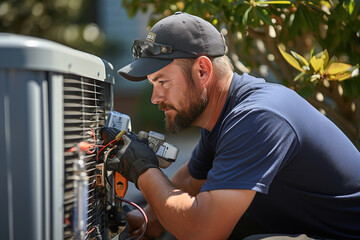Ac Repair San Antonio TX: A Comprehensive Guide to Common Air Conditioning Problems
However, like any electric appliance, they are susceptible to a variety of issues that can affect their performance and longevity. Here, we’ll explore the nine most common air conditioning problems and offer tips on how to identify and understand them.
- Dirty Condenser CoilsIf they get too dirty or covered in debris, it becomes difficult for your AC to function properly which can result in overheating and part failure.
- Thermostat Issues: Sometimes, it’s not even an issue with the AC unit itself, but the thermostat causing the problem. An improperly calibrated thermostat can result in uncomfortable temperatures and a sky-high utility bill.
- Capacitor Issues: If your capacitor isn’t working properly, your air conditioner’s motor may not run or start at all. This electronic component starts the motor and keeps running after startup.
- Compressor Problems: The compressor is like the heart of your AC system that circulates refrigerant between the indoor and outdoor units. If it’s not working correctly, your entire system won’t cool properly.
Understanding these common problems can help homeowners identify when their air conditioning system may need professional attention. Regular maintenance checks by a professional can prevent these issues and keep an air conditioning system running smoothly for longer periods.
A Comprehensive Guide to Air Conditioning Repair in San Antonio
Here is a guide on air duct cleaning san antonio.
.It’s critical to understand the factors contributing to this issue, how to detect them, and ultimately, how to fix them.
Causes of Water Leaks in AC Units
Air conditioners typically generate condensation during operation, which should be correctly drained outside of your home.
- Damaged or Disconnected Drain Pan: The drain pan catches the condensation produced by the AC unit. If it is damaged or dislodged, water can spill over and cause a leak.
- Low Refrigerant LevelsWhen this ice melts, it can lead to excessive water that the drain pan may not be able to handle.
Detecting Indoor Water Leaks
Identifying a leak early on can save you from costly repairs down the line.
- Moldy Smell: Persistent dampness due to a leaking AC could lead to mold growth. This usually comes with a musty odor.
Fixing Indoor Water Leaks
While some minor issues can be fixed at home, most AC-related water leaks might require the help of a professional.
- Unclogging the Drain Line: You can try to unclog the drain line using a wet/dry vacuum. If that doesn’t work, contacting an HVAC professional would be your best bet.
- Replacing the Drain Pan: If inspection reveals a damaged or dislocated drain pan, replacing it should solve your problem.
- Recharging Refrigerant Levels: This should be done by an experienced technician as it involves handling potentially harmful substances.
It’s imperative to note that regular maintenance is the best way to prevent indoor water leaks from your air conditioner. Professional HVAC technicians typically check for problems like clogged drain lines or low refrigerant levels during routine service calls, minimizing the chances of a leak occurring in the first place.
Acquiring Top Quality AC Repair Services in San Antonio
One of the most common issues that homeowners face with their air conditioning systems is a refrigerant leak.
What Causes Refrigerant Leaks?
Refrigerant leaks occur when the copper tubing of your AC system develops holes or cracks.
- Formicary Corrosion: This type of corrosion is caused by formic acid, which is often present in household cleaning products and can slowly eat away at the copper tubing over time.
- Vibration: Constant vibration from an operating AC system can cause wear and tear on the tubing.
- Poor Installation: If the AC unit isn’t properly installed, it may lead to premature wear and tear on various components including the copper tubing.
Impacts of Refrigerant Leaks
- This results in longer run times and higher energy bills.
- Reduced Lifespan: Constantly running low on refrigerant forces the compressor to work harder than necessary which may shorten its lifespan significantly.
- Environmental Harm: Most older AC units use HCFCs (hydrochlorofluorocarbons) as a refrigerant. When these HCFCs escape into the atmosphere through leaks, they contribute to ozone depletion.
How Can You Detect a Refrigerant Leak?
- High Energy Bills: A sudden spike in your energy bills without a noticeable change in usage could indicate a leak.
- Hissing Noise: While most refrigerant leaks are silent, larger leaks can sometimes produce a slight hissing or bubbling noise.
Preventive Measures and Solutions
- Regular Maintenance: Have your AC system regularly serviced by a professional to check for any signs of wear and tear or potential leaks.
- Replace Old Units: Older units that use harmful HCFCs can be replaced with new models that use environmentally friendly alternatives.
In case of an existing leak, it’s imperative to call in professionals for an immediate repair. Contrary to common belief, simply adding more refrigerant isn’t a solution as the leak will persist and continue draining the additional refrigerant. Only a repair or replacement of the affected part can effectively solve the problem.
Air Conditioning Repair in San Antonio, TX: Solutions for Overworking and Underperforming AC Units
This relentless operation can often lead to underperformance, causing discomfort and skyrocketing energy bills.
HVAC Repair San Antonio: HVAC Repair Solutions in San Antonio TX System
- Faulty Thermostat: A malfunctioning thermostat can send false signals to the AC unit that more cooling is needed, resulting in constant operation.
- Leaky Ducts: Leaky ductwork allows cool air to escape before reaching living spaces, prompting the system to work harder.
- Dirty Filters: When air filters are clogged with dirt and dust, they restrict airflow. This causes the unit to work overtime trying to maintain a cool temperature.
Solutions for an Overworking AC
Addressing this issue involves diagnosing the root cause.
- Correct SizingConsult with a professional who can correctly measure and recommend the right size.
- Thermostat Check-up: Regularly inspect your thermostat for any malfunctions or incorrect settings that may be causing unnecessary operation.
- Seal Ductwork: If leaky ducts are suspected, seek professional help for duct sealing or replacement.
- Regular MaintenanceRegularly scheduled professional maintenance can also prevent issues from arising.
The Importance of Addressing an Overworking AC
- Improved Comfort: A properly functioning AC unit ensures your home is cooled evenly and comfortably.
- Lower Energy Bills: An overworked air conditioning system consumes more energy, therefore addressing this issue can result in significant savings on your utility bills.
While some issues can be resolved independently, some may require professional expertise. If you’ve tried troubleshooting without success or if you’re unsure where to start, consider reaching out to an air conditioning expert who can assess your system accurately. A regularly maintained and efficiently functioning AC unit is key to a comfortable and cool home environment.
Unmasking the Culprit behind No Cold Air Issue in your Air Conditioning System
But what if your AC system stops producing cold air? Let’s delve into the primary reasons why this could happen and how to fix it.
Causes of No Cold Air Issue
- Low Refrigerant LevelIf its level is low, it may not effectively cool the air.
- Dirty Air Filter: A clogged or dirty filter restricts airflow through the unit, affecting its efficiency and ability to cool the air.
- Condenser Issues: Your condenser could be blocked or dirty, which means it won’t be able to release heat adequately, resulting in warm air.
How to Fix No Cold Air Issue
Fixing no cold air issue requires diagnosing the problem accurately first.
- Check Your Thermostat Settings: Ensure that your thermostat is set to “Cool” mode and not “Heat,” which can sometimes happen accidentally.
- Examine Your Air Filter: Regularly inspect and replace dirty filters with new ones every 30 to 90 days for optimal functioning of your AC system.
- Inspect Your Outdoor Condenser Unit: Make sure there isn’t any blockage around the outdoor condenser unit and clean off any debris or dirt on it.
- Check for Refrigerant Leaks: The refrigerant levels should be checked by a professional technician, who can also fix any leaks if found.
If you’ve tried these steps and are still experiencing issues, it’s time to call a professional technician. They have the tools and knowledge necessary to diagnose and fix more complex problems.
Preventive Maintenance
To avoid facing no cold air issue in your AC system, preventive maintenance is crucial.
- Regular Filter Replacement: As already mentioned, this step can significantly improve your AC’s efficiency.
- Routine Inspections: Having a professional regularly check your system can help identify potential issues before they become severe.
Even the best-maintained system can occasionally run into issues. However, regular preventive measures will keep your AC system efficient for a longer period reducing the chances of warm air blowing out of your unit.
- Ac Repair San Antonio TX: A Comprehensive Guide to Common Air Conditioning Problems
- Understanding AC Repair Services in San Antonio TX
- Comprehensive 17-Step Checklist for Successful Air Conditioner Maintenance in Hot Weather Conditions
- Air Conditioning Repair in San Antonio: How Regular Maintenance Can Extend Your Unit’s Lifespan
- Comprehensive Guide to AC Repair in San Antonio TX: Tips from Top Industry Experts

